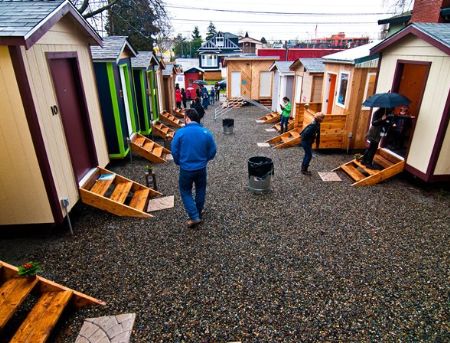by Larry
February, 2019Tiny Houses in AmericaFor a variety of reasons, over the past few years a number of miniature dwelling villages have sprung up in our country, capturing the imaginations and filling the needs of many as we continue to discover creative ways to adapt and make good use of our resources in the 21st Century. House sizes in the U.S., particularly after the Great Recession, have tended toward the large or small, with less building occurring, in relation to the need, in the large middle range. Thus there are quite a volume of expensive homes being built that are at least 3000 square feet. These now represent about a third of new single family housing. Though as yet few in absolute numbers, a trend is picking up, on the other hand, for the construction of small houses, dwellings usually in the 60-800 square foot range. In fact, those that are really fetching media attention normally do not exceed 400 square feet. Unfortunately, a dearth of new mid-size homes despite an increasing population of small households means that demand is rising faster than supply, and so, naturally enough, costs and rents of mid-level homes are going up steadily and far faster than average wages. A major reason companies are not building or selling less spacious abodes is that back in the early- to mid-2000s many financial institutions went overboard in constructing and financing the kinds of houses people really need but then lost billions or even had to declare bankruptcy during and immediately after the monetary meltdown that got underway big time in the fall of 2008. Now similar companies mainly want to deal with people with plenty of cash, great credit, and/or abundant income, and these are more likely to be the types of buyers of the bigger homes. In addition, the federal government is now less involved in assisting first-time home buyers than was the case prior to 2008. The feds and their Fannie Mae and Freddie Mac institutions also took a beating in the huge economic downturn of 2007-2009. Meanwhile, though, job opportunities have also been worse since 2008, and when people could find decent work it often has paid less than would probably have been the case if not for the Great Recession. Inevitably, people's budgets have been squeezed in a major way, and they have had to settle for less than ideal solutions such as living with parents, siblings, or in-laws, sharing places with other renter households, staying in trailer homes, and renting more and more expensive apartments. Older folks too have been reaching retirement age without as many resources as might have been the case if not for a significant loss of equity in houses, IRA or 401k accounts, common stocks, or mutual funds, on the one hand, and slow economic circumstances following the 2008 debacle, on the one other.
Non-profits as well as local governments have wanted to lend a hand to people in need, yet to do so in more cost-effective ways than might have been the case in the past. At the same time, the environmental movement has motivated a number of progressives to look for simpler, lower carbon-footprint ways of living. There has thus been plenty of impetus for the tiny house movement. So diminutive abode villages have been started in multiple locations around the country, for example in AZ, CA, CO, FL, GA, MI, MN, NC, NV, OR, and WA. Chances are, if interested in a much less costly adaptation to modern comfort and convenience, there is a tiny house community not too far from you that might well fit your lifestyle. To get started, one might only need to ask a preferred search engine for "tiny houses," then plug in the locales that intrigues you most. There are tiny house enclaves with plenty of space between residences, ones where you can rent vs. buy, places that only accept women, ones that allow drugs and those that definitely do not, communities in big, middle, or smaller cities as well as in rural areas, ones in picturesque landscapes, others close to urban job centers and public transportation, etc. How much might these small living spaces actually set you back? The prefab materials for one can run as low as $4000. In fact, prefab container homes can be bought for under $3000. Ready-built, tiny residences often go for only about $12,000, yet fancier ones in certain locations sell for as high as $90,000 or so. Some of the rents of tiny houses are subsidized for low-income occupants, and virtually all are much lower in rental prices than for average dwellings. The best opportunities seem to be in little communities of other tiny house dwellers who often share kitchen, dining, or showering facilities and look out for one another while also providing companionship and other social or recreational opportunities. While not for everyone, these look to be a great option for a growing number in the U.S. and could just be what you are looking for too, if not now, then perhaps at a later stage of your life. Primary sources: A Guide to Tiny House Communities. in tinyhousecitizens.com; August 29, 2018; Non-profits put small-footprint homes to versatile use. Pam Bailey in neighborworks.org; August 4, 2017; Tiny House Communities You Want to Join in 2018. Molli McGee in tinysociety.com; August 29, 2018. |
